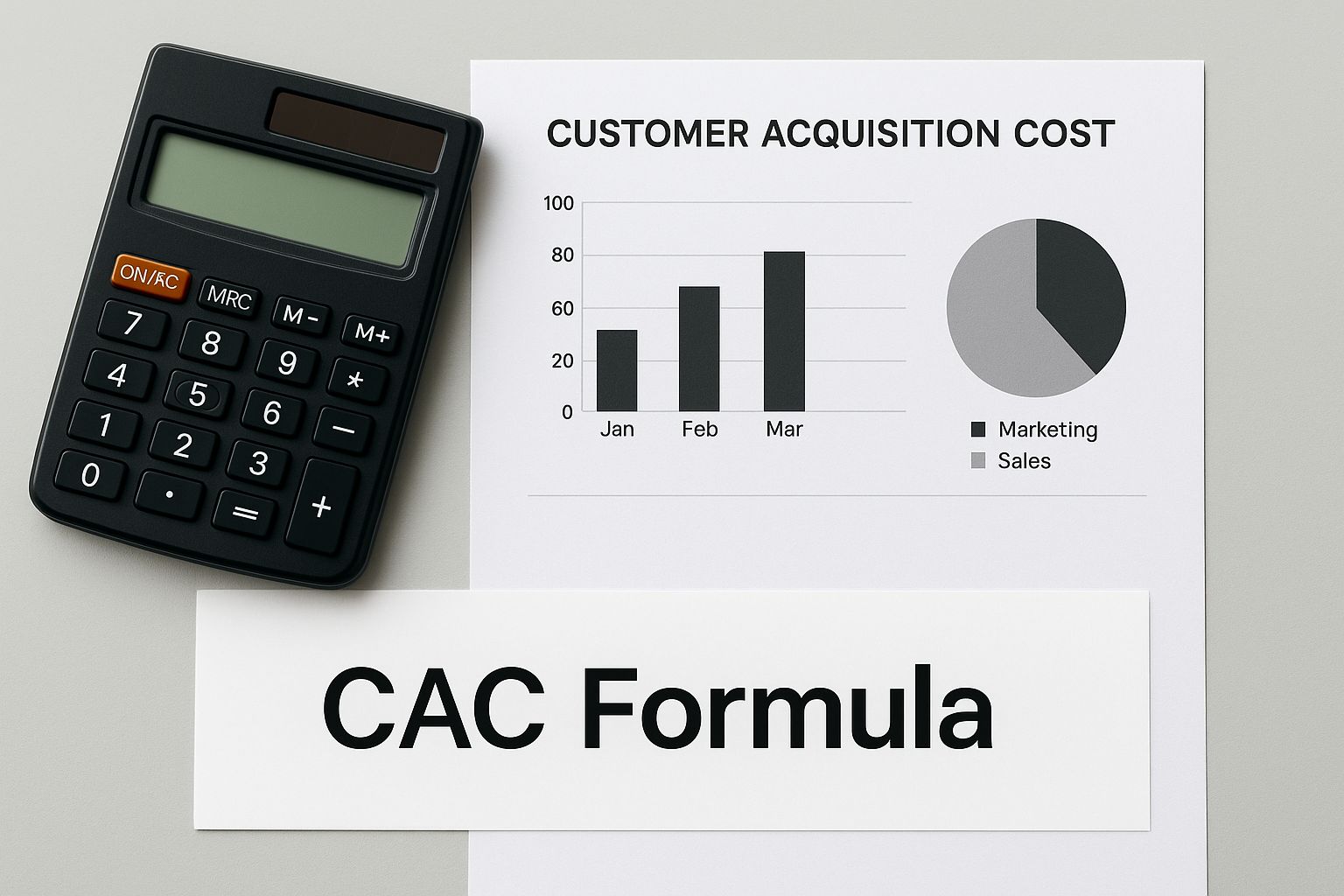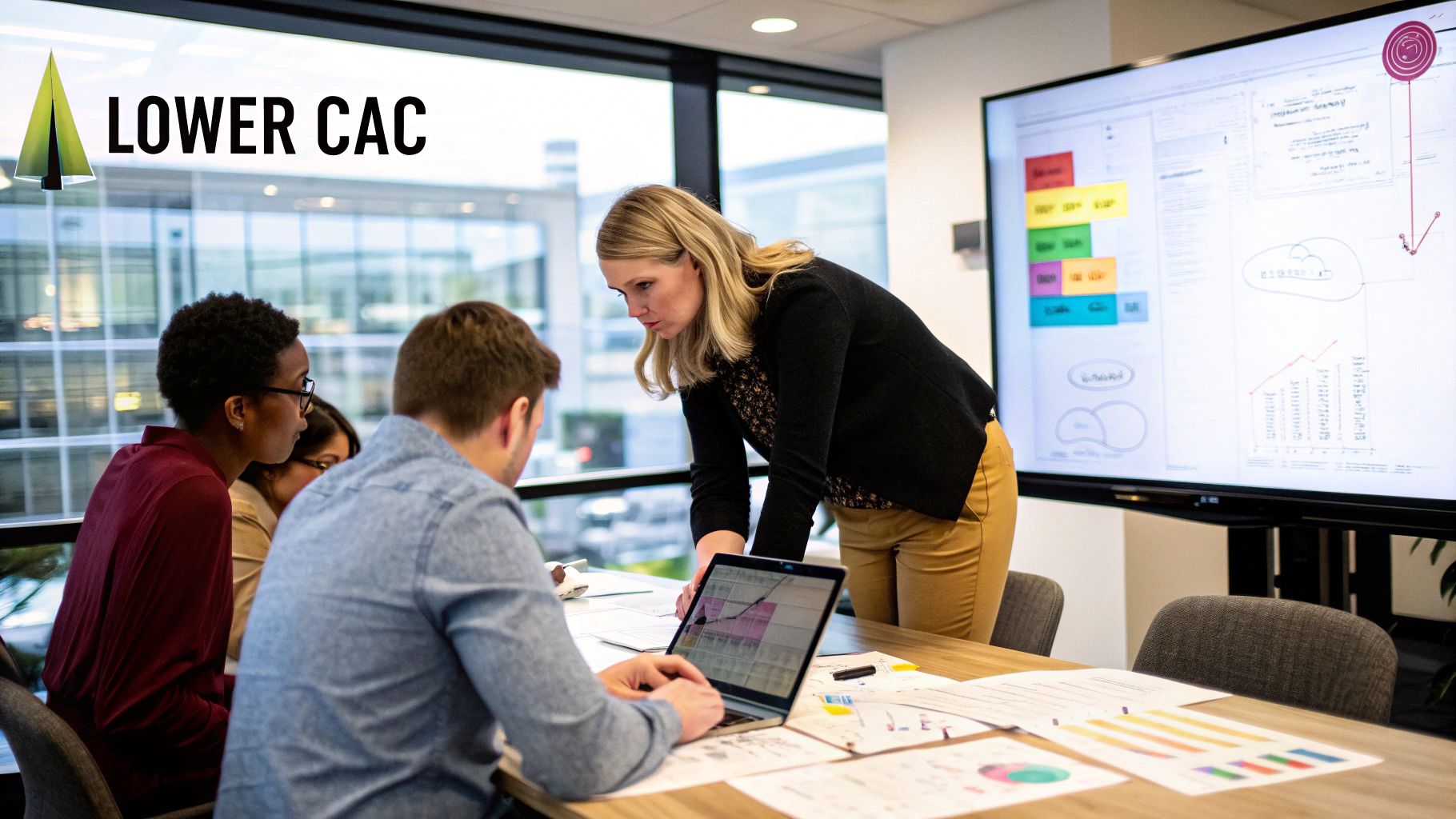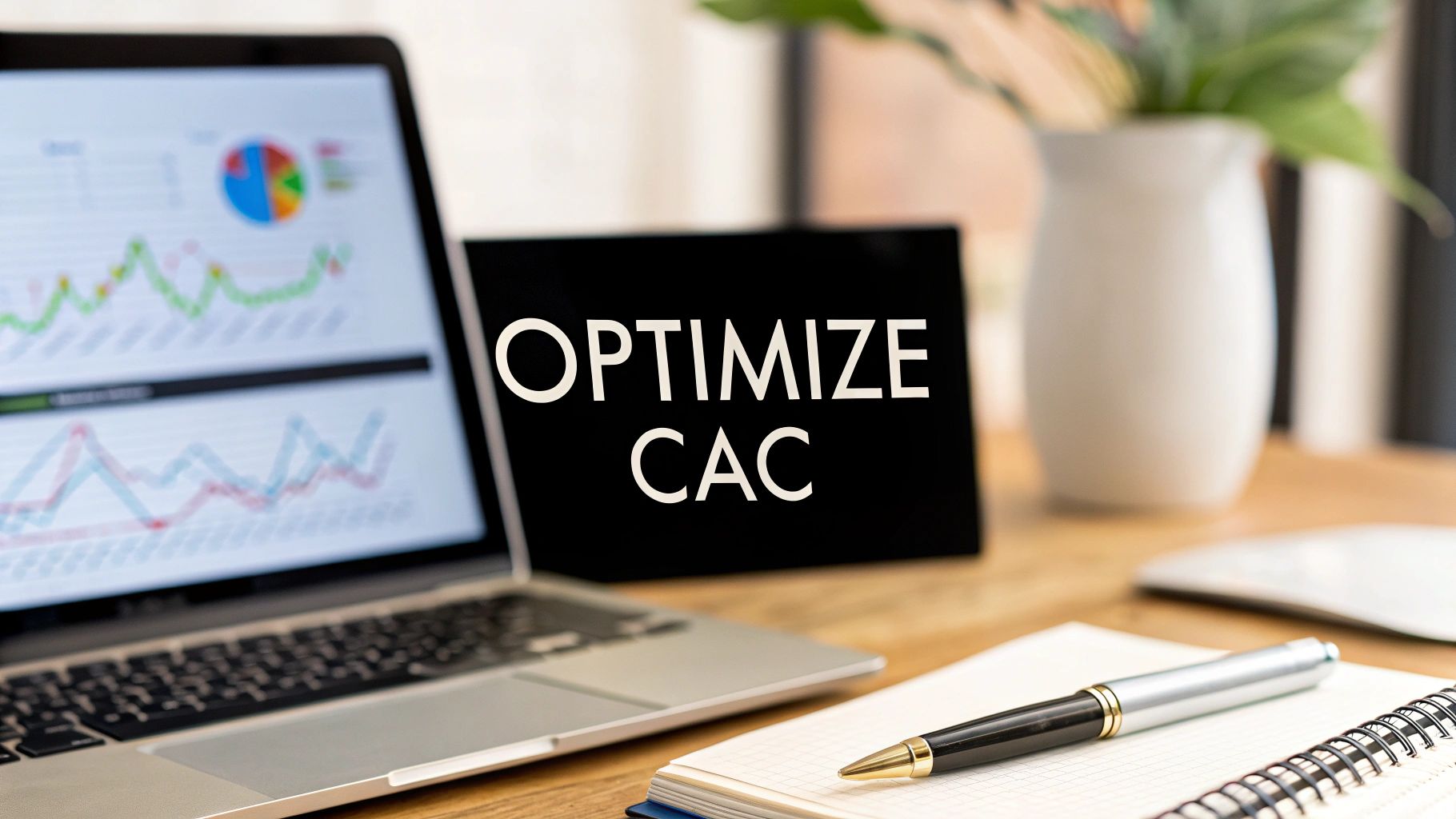Decoding SaaS Customer Acquisition Cost Fundamentals

In the SaaS world, Customer Acquisition Cost (CAC) is a critical metric. It represents the total investment needed to turn a potential customer into a paying one. This cost has a direct impact on profitability, available funding, and overall growth. Understanding CAC is essential for smart investments and effectively scaling your SaaS business.
What Constitutes CAC?
CAC is more than just your advertising spend. It includes all expenses directly tied to gaining new customers.
- Marketing Expenses: This covers paid advertising, content creation, SEO efforts, social media marketing, and email marketing.
- Sales Costs: Include salaries and commissions for your sales team, sales tools, and CRM subscriptions.
- Onboarding Expenses: Consider the resources used to get new customers started, like training materials and support staff.
For example, if you spend $20,000 on marketing and sales in a month and acquire 20 new customers, your CAC is $1,000. This calculation is straightforward but has major implications for your business’s financial well-being.
Industry Benchmarks and Variations
CAC values vary widely across the SaaS industry. SaaS companies pay an average of $702 to acquire a new customer. This number changes significantly based on industry, business model, and company size. The metric is important because it directly impacts profitability and growth plans. For example, some sectors, like fintech, have average CACs as high as $1,450. Learn more about industry averages. Understanding these benchmarks helps assess your own performance.
B2B SaaS businesses often have higher CACs than B2C companies because of longer sales cycles and more complex onboarding. Early-stage startups also typically have higher CACs as they build brand awareness and refine their targeting. A seemingly high CAC might be reasonable, depending on your specific situation.
The Importance of Context
Industry benchmarks are helpful, but it's important to interpret your CAC within your own business context. Factors like your target market, pricing model, and customer lifetime value (LTV) affect what a "good" CAC is. This is where the LTV:CAC ratio comes in, offering a more complete view of your acquisition efforts. A healthy LTV:CAC ratio ensures that each customer's value significantly outweighs the cost of acquiring them, creating sustainable growth. By considering these factors, you can set realistic CAC targets for your business.
Calculating Your SaaS Customer Acquisition Cost With Precision
Accurately calculating your Customer Acquisition Cost (CAC) is essential for any SaaS business. It provides critical insights into your financial performance and helps you make informed decisions about growth. This isn't about rough estimates; it requires a precise methodology that delivers actionable data. We'll explore which expenses should be included in your CAC calculation, drawing on best practices from successful SaaS companies.
Defining True CAC: Beyond Marketing Spend
While marketing is a significant factor, your CAC includes all costs directly associated with acquiring new customers. This broader perspective provides a more accurate picture of your spending. Here's a breakdown:
Sales Salaries and Commissions: Include the full compensation of your sales team. This covers salaries, commissions, bonuses, and any other incentives tied to new customer acquisition.
Marketing Costs: This encompasses a wide range of activities, from paid advertising and content creation to SEO, social media marketing, and email campaigns. Consider every marketing expense aimed at attracting new customers.
Sales and Marketing Tool Costs: Factor in the cost of essential software and platforms, such as your CRM (Customer Relationship Management) system, marketing automation tools, and any other technology used by your sales and marketing teams.
Onboarding Expenses: Don't forget the resources dedicated to onboarding new customers. This includes training materials, customer success team salaries, and any specialized onboarding software.
To illustrate, let's say your combined sales and marketing expenses for a month total $50,000, and you acquire 50 new customers during that period. Your CAC is $1,000. This simple calculation offers a powerful overview of your spending effectiveness. For a more detailed understanding of CAC principles, check out the Customer Acquisition Cost Fundamentals.
To provide a more detailed explanation of cost inclusion in your CAC calculations, let's review the following table:
SaaS CAC Calculation Components A breakdown of all costs that should be included in your CAC calculation
| Cost Category | Examples | Inclusion Guidance | Impact on Total CAC |
|---|---|---|---|
| Sales Salaries & Commissions | Base salaries, commissions, bonuses, benefits for sales staff directly involved in acquiring new customers | Include all costs associated with compensating the sales team responsible for closing deals with new customers. | Directly increases CAC. A higher sales compensation structure will lead to a higher CAC. |
| Marketing Costs | Paid advertising (PPC, social media ads), content marketing, SEO, email marketing, events, public relations | Include all marketing efforts aimed at attracting and converting new customers. | Directly increases CAC. More aggressive marketing campaigns will typically result in a higher CAC. |
| Sales & Marketing Tool Costs | CRM software, marketing automation platforms, sales intelligence tools, lead generation software | Include the cost of all tools used by the sales and marketing teams to acquire new customers. | Directly increases CAC. Investing in more sophisticated tools can increase CAC, but may also improve efficiency in the long run. |
| Onboarding Expenses | Customer success team salaries, onboarding materials, training resources, implementation costs | Include costs associated with getting new customers up and running and integrated with your product or service. | Directly increases CAC. A more comprehensive onboarding process can increase CAC, but may also improve customer retention. |
This table highlights the key cost categories to consider when calculating CAC, offering specific examples and explaining how they affect the overall calculation. By accurately accounting for these costs, you gain a clearer picture of your acquisition efficiency.
Segmenting for Deeper Insights
While a blended CAC provides a general overview, segmenting your CAC can reveal valuable insights into specific areas for improvement. Consider breaking down your CAC by the following:
Customer Type: Analyze the differences in CAC between different customer segments, such as enterprise clients versus small businesses. You might find that acquiring enterprise clients is more expensive, but also yields a higher lifetime value.
Geography: Different regions may have varying acquisition costs due to market conditions, competition, and other factors. This knowledge allows you to optimize your regional marketing strategies.
Acquisition Channel: Compare the CAC of different channels, like paid advertising, social media, or referrals. This helps you identify your most cost-effective channels and allocate your budget accordingly. For more insights into referral programs, see How to Master SaaS Referral Programs.
This granular approach helps pinpoint which customer segments, locations, and channels offer the best return on investment. It empowers you to make data-driven decisions, optimize your targeting, and allocate resources effectively. This focused strategy can significantly improve your overall acquisition efficiency and drive sustainable growth.
Benchmarking SaaS Customer Acquisition Cost By Industry
Understanding your customer acquisition cost (CAC) is crucial for any SaaS business. However, a "good" CAC isn't a fixed number. It varies significantly across industries. What might be a perfectly acceptable CAC in one sector could be unsustainable in another. This section explores industry-specific CAC benchmarks, drawing on research and insights from SaaS investors and operators. We'll examine how factors like business models and product complexity influence acceptable CAC thresholds. We'll also look at how successful SaaS companies analyze their CAC within their specific markets.
Understanding Industry Variations

The infographic above illustrates the elements of a typical SaaS CAC formula, alongside financial tools like spreadsheets and calculators. This emphasizes the critical role of precise calculation for accurate insights. A correctly calculated CAC ensures all expenses are considered, from marketing and sales to onboarding. This comprehensive understanding allows businesses to evaluate profitability and refine their strategies for sustainable growth.
B2B vs. B2C: A Tale of Two CACs
B2B and B2C SaaS companies operate in vastly different environments. This impacts their CAC in important ways. B2B enterprise SaaS often has CACs 4-5x higher than those targeting small and medium-sized businesses (SMBs). This is primarily because B2B sales cycles are longer and more complex. They involve multiple stakeholders and personalized sales strategies.
Closing an enterprise deal can take months of relationship building, demos, and negotiations. Acquiring an SMB customer might take only a few days. As a result, B2B SaaS companies often have higher initial CACs, but also aim for a higher customer lifetime value (LTV) to balance this out.
B2C SaaS typically involves shorter sales cycles and less intensive sales interactions. These companies can utilize scalable marketing channels like social media marketing and content marketing. This often leads to lower CACs, but also creates pressure to scale the customer base quickly.
Product Complexity and CAC
The complexity of a SaaS product influences its acceptable CAC. A product with a difficult learning curve or one needing significant implementation may require more investment in onboarding and longer sales cycles, thus raising the CAC.
Complex products often demand greater investment in customer success and support. This ensures successful onboarding and continued customer satisfaction. A higher CAC can be justified if it leads to a higher LTV through improved customer retention and lower churn.
Industry Benchmarks and Shifting Economics
Some industries simply tolerate higher CACs. Fintech SaaS, for example, often sees CACs over $1,000 due to the high value and complexity of financial services. Other verticals, like productivity tools, often have much lower CACs.
Furthermore, acquisition economics can change within industries due to competition or evolving customer behavior. If a competitor enters a market with a lower-priced product, existing companies may need to adjust their strategies. This could mean reducing prices, increasing marketing spend, or concentrating on niche markets.
To help visualize these industry differences, let's look at a table summarizing typical CAC benchmarks:
SaaS CAC Benchmarks by Industry Vertical
| Industry Vertical | Average CAC | Typical CAC Range | Key Influencing Factors |
|---|---|---|---|
| Fintech | $1,000+ | $500 - $2,000+ | High contract value, complex sales cycles |
| Sales & Marketing | $500 - $1,000 | $200 - $1,500+ | Competitive landscape, sales model |
| HR Tech | $300 - $700 | $100 - $1,000 | Company size, features offered |
| Productivity Tools | $100 - $300 | $50 - $500 | Freemium models, viral marketing |
This table highlights the wide range of CACs across SaaS sectors. Fintech's high average CAC contrasts sharply with the lower figures for productivity tools. This underscores the importance of understanding industry context.
Establishing Realistic Targets
Instead of chasing arbitrary benchmarks, successful SaaS companies create realistic CAC targets aligned with their market position and growth stage. Early-stage startups might accept higher CACs to build brand awareness and market share.
As companies mature, optimizing CAC for profitability and sustainable growth becomes increasingly important. This might involve improving targeting, optimizing marketing channels, and streamlining sales processes. By aligning CAC targets with their specific circumstances, SaaS businesses make strategic decisions for long-term success.
Mastering the LTV:CAC Ratio for Sustainable Growth

Customer Acquisition Cost (CAC) in SaaS is essential, but it's only one part of the bigger picture. The key to sustainable growth lies in understanding the relationship between CAC and Customer Lifetime Value (LTV). This is where the LTV:CAC ratio becomes so important. It's a vital metric for evaluating the long-term health and profitability of a SaaS business. This section explores why this ratio is so important to investors, how different business models impact ideal target ratios, and practical strategies for improvement.
Why the LTV:CAC Ratio Matters
The LTV:CAC ratio provides critical insights into the health of your SaaS business. It shows how much value you gain from each customer compared to how much it costs to acquire them. Investors value this ratio because it demonstrates the long-term viability and scalability of your business model. A healthy LTV:CAC ratio ensures you're not just acquiring customers, but acquiring profitable customers who contribute to overall growth.
For example, an LTV:CAC ratio of 3:1 means that for every dollar spent on acquisition, you generate three dollars in revenue over the customer's lifetime. This shows a strong return on investment and efficient acquisition strategies.
A key factor in managing SaaS customer acquisition costs is the CAC ratio, which compares acquisition cost to the revenue generated over time. A CAC ratio below 1 is excellent, indicating the acquisition cost is less than one month's revenue. Maintaining a sustainable CAC ratio is crucial for scalability.
For instance, companies with high CAC, such as those in fintech, must ensure the revenue from each customer justifies the acquisition cost. They often aim for an LTV:CAC ratio of 3:1 or 4:1. Balancing this requires careful monitoring of both CAC and LTV to ensure acquisition strategies align with growth goals. Find more detailed statistics here.
Optimal LTV:CAC Ratio Targets
While a higher LTV:CAC ratio is generally preferred, the ideal target depends on your business model and pricing strategy. Businesses with high customer churn may require a higher ratio to offset customer losses. Businesses with low churn and high customer retention may find a lower ratio acceptable.
Your pricing strategy also matters. With a high Average Revenue Per User (ARPU), you can afford a higher CAC and maintain a healthy ratio. Learn more about reducing customer churn.
Balancing the Equation: Strategies for Improvement
If your LTV:CAC ratio is unbalanced, you have two main options: increase LTV or decrease CAC. Here are some practical strategies:
Boosting LTV: Focus on customer retention and increasing ARPU. Tactics include improving customer onboarding, providing excellent customer support, implementing upselling and cross-selling strategies, and developing customer loyalty programs.
Reducing CAC: Optimize your marketing and sales efforts for more efficient customer acquisition. Strategies include refining targeting, optimizing marketing channels, improving sales conversions, and leveraging lower-cost methods like content marketing and referrals.
Proven Strategies to Reduce SaaS Customer Acquisition Cost
Reducing your SaaS customer acquisition cost (CAC) is crucial for sustainable growth. It's about strategically investing in activities that deliver the highest return. By examining the methods of successful growth leaders, we can identify effective strategies for measurable results, regardless of budget.
Content-Driven Acquisition: Building a Lead-Generating Engine
One powerful strategy is using a content engine. This involves creating high-quality content that attracts and educates potential customers. This could include blog posts, webinars, guides, and case studies. For example, a SaaS company offering project management software could create a blog post titled "10 Ways to Improve Team Productivity with Project Management Software." This attracts organic traffic, establishes your expertise, and nurtures leads.
This approach is cost-effective compared to paid advertising.
The Power of Referrals: Turning Customers Into Advocates
Targeted referral programs are another effective approach. These programs incentivize existing customers to recommend your product. This turns your user base into an acquisition channel, leveraging their trust and influence. This is particularly impactful for SaaS businesses, as word-of-mouth can significantly affect purchasing decisions.
This strategy reduces CAC and builds customer loyalty and brand reputation. You might be interested in: How to master B2B SaaS marketing strategies.
Hyper-Personalization: Reaching the Right Customer at the Right Time
Hyper-personalization can drastically improve conversion rates. This involves tailoring your messaging based on individual prospect needs and interests. This might include segmenting your email list based on user behavior or building targeted landing pages for different customer personas.
This focused approach creates a more engaging customer experience, increasing conversion likelihood. Using dynamic website content to show relevant case studies based on a visitor's industry is one highly effective example.
Product-Led Growth: Letting the Product Speak for Itself
Finally, many high-performing teams embrace product-led acquisition strategies. This approach prioritizes a seamless and valuable user experience that drives organic growth. Offering a freemium model or free trial lowers the barrier to entry and lets potential customers experience the product's value.
This reduces reliance on traditional marketing spend and accelerates growth through word-of-mouth. Understanding Lifetime Value (LTV) is essential when evaluating your CAC; learn more about how to Calculate Lifetime Value SaaS. This allows you to optimize pricing and marketing based on projected customer LTV, ensuring profitable growth. By focusing on core product value, you attract genuinely interested customers, reducing CAC and driving long-term success.
Strategic CAC Investment: When To Spend More, Not Less
Optimizing Customer Acquisition Cost (CAC) is a primary goal for any SaaS business. However, there are times when strategically increasing your CAC can actually lead to greater long-term returns. This section explores those scenarios where a higher CAC is not just acceptable, but a smart investment for future growth.
Identifying Opportunities for Strategic CAC Increase
Sometimes, market conditions warrant a temporary shift away from strict CAC optimization. For example, consider the emergence of a new market segment. This could be expanding into a new geographic region or targeting a previously untapped customer demographic. Aggressively pursuing these new opportunities might require increased spending on marketing and sales to gain an initial foothold. This often translates to a temporarily higher CAC in exchange for early market share.
Another situation that might justify a higher CAC is a rapidly changing competitive landscape. If a competitor launches a disruptive product or implements a new pricing strategy, you may need to respond strategically. This could involve increasing your marketing and sales efforts to maintain or improve your position, even if it temporarily raises your CAC. Consider this an investment in protecting and potentially expanding your market share.
Building Alignment for Strategic Investment
Before significantly increasing your CAC, it's vital to align your team, board, and investors. Clearly communicate the reasoning behind the strategic investment. Explain how the temporary increase in CAC is projected to generate disproportionate long-term returns through gains in market share or a stronger competitive advantage. This transparency builds confidence and ensures everyone is on board with the plan. Focus on the projected long-term value rather than short-term CAC fluctuations.
Implementing Measurement and Accountability
While strategic spending can be advantageous, maintaining accountability is crucial. Implement robust measurement systems to track the effects of your increased CAC. Define Key Performance Indicators (KPIs) that align with your strategic objectives, such as market share growth in the new segment or customer acquisition rate within the competitive market. Regularly monitor these KPIs to ensure your increased investment is producing the desired results.
Knowing When To Pull Back
Strategic CAC increases are not meant to be permanent. Once you’ve achieved your objectives, like capturing sufficient market share or establishing a competitive edge, it’s time to shift back to optimization. Refine your targeting, streamline processes, and explore more cost-effective acquisition channels to reduce your CAC. This balance of strategic investment and efficient optimization is essential for sustainable, long-term growth.
Ready to leverage the power of referrals and significantly reduce your customer acquisition costs? Refgrow, an innovative embedded affiliate software, empowers SaaS businesses to transform their existing users into a powerful acquisition channel. With seamless integration, customized design, and automated tracking, Refgrow allows you to quickly launch and scale your referral program. Eliminate transaction fees, unlock unlimited earning potential, and drive sustainable growth without increased ad spend. Visit Refgrow today to learn more and transform your customer base into a revenue-generating engine.

